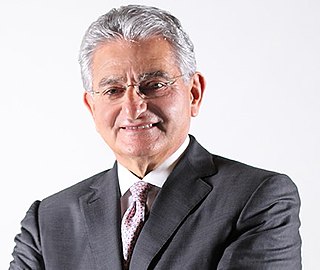
Beirut is the capital and largest city of Lebanon. As of 2014, Greater Beirut has a population of 2.5 million, which makes it the fourth-largest city in the Levant region and the seventeenth-largest in the Arab world. The city is situated on a peninsula at the midpoint of Lebanon's Mediterranean coast. Beirut has been inhabited for more than 5,000 years, making it one of the oldest cities in the world.

Gibran Khalil Gibran, usually referred to in English as Kahlil Gibran, was a Lebanese-American writer, poet and visual artist; he was also considered a philosopher, although he himself rejected the title. He is best known as the author of The Prophet, which was first published in the United States in 1923 and has since become one of the best-selling books of all time, having been translated into more than 100 languages.
Aintoura is a town and municipality in the Keserwan District of the Keserwan-Jbeil Governorate, Lebanon. It is located 18 kilometers north of Beirut. The average elevation of Aintoura is 230 meters above sea level and its total land area is 71 hectares. Its inhabitants are predominantly Maronite Christians.

Armenians have lived in Lebanon for centuries. According to Minority Rights Group International, there are 156,000 Armenians in Lebanon, around 4% of the population. Prior to the Lebanese Civil War, the number was higher, but the community lost a portion of its population to emigration.

Bourj Hammoud is a town and municipality in Lebanon located north-east of the capital Beirut, in the Matn District, and is part of Greater Beirut. The town is heavily populated by Lebanese Armenians.

Dahieh is a predominantly Shia Muslim suburb in the south of Beirut, in the Baabda District of Lebanon. It has a minority of Sunni Muslims, Christians, and a Palestinian refugee camp with 20,000 inhabitants. It is a residential and commercial area with malls, stores and souks, and comprises several towns and municipalities. It is north of Rafic Hariri International Airport, and the M51 freeway that links Beirut to the airport passes through it.

The Beirut Central District is the historical and geographical core of Beirut, the capital of Lebanon. Also called downtown Beirut, it has been described as the “vibrant financial, commercial, and administrative hub of the country.” It is thousands of years old, with a traditional focus of business, finance, culture, and leisure.

Saint Joseph University of Beirut is a private Catholic research university in Beirut, Lebanon, founded in 1875 by French Jesuit missionaries and subsidized by the Government of France during the time when Lebanon was under Ottoman rule.
Dora also spelled Doura or Daura, is a suburb north-east of Beirut in the Matn District of Mount Lebanon Governorate. The suburb has commercial and residential zones. Dora is administered by Bourj Hammoud municipality.

Bourj el-Barajneh is a municipality located in the southern suburbs of Beirut, in Lebanon. The municipality lies between Beirut–Rafic Hariri International Airport and the town of Haret Hreik.

The Beirut River is a river in Lebanon separating the city of Beirut from its eastern suburbs, primarily Bourj Hammoud and Sin el Fil. The river flows mostly east to west from snow drains and springs on the western slopes of Mount Kneisseh and the southern end of Mount Sannine near the towns of Hammana and Falougha, before curving north and emptying at Beirut's northern Mediterranean coast, east of the Port of Beirut. According to popular legend, St. George slew the dragon in a spot near the mouth of the river.

Kaukaba, Kaukabet El-Arab or Kaukaba Station is a village in the Hasbaya District in the Nabatiye Governorate in southern Lebanon.

The American University of Science and Technology is a private, non-sectarian, and co-educational American university in Lebanon.
The Baháʼí Faith (بهائی) has a following of at least several hundred people in Lebanon dating back to 1870. The community includes around 400 people, with a centre in Beit Mery, just outside the capital Beirut, and cemeteries in Machgara and Khaldeh. On the other hand, the Association of Religion Data Archives estimated some 3,900 Baháʼís in 2005.

Charles Corm (1894–1963) was a Lebanese writer, industrialist, and philanthropist. He is considered to be the leader of the Phoenicianism movement in Lebanon which ignited a surge of nationalism that led to Lebanon's independence. In a country torn by sectarian conflicts, Corm's intention was to find a common root shared by all Lebanese beyond their religious beliefs. At the age of 40, he quit a successful business empire to dedicate his time to poetry and writing.

The architecture of Lebanon embodies the historical, cultural and religious influences that have shaped Lebanon's built environment. It has been influenced by the Phoenicians, Romans, Byzantines, Umayyads, Crusaders, Mamluks, Ottomans and French. Additionally, Lebanon is home to many examples of modern and contemporary architecture. Architecturally notable structures in Lebanon include ancient thermae and temples, castles, churches, mosques, hotels, museums, government buildings, souks, residences and towers.

The Great Famine of Mount Lebanon (1915–1918), also known as Kafno, was a period of mass starvation on Mount Lebanon during World War I that resulted in the deaths of 200,000 people, most of whom were Maronite Christians.

Salim Georges Sfeir is a Lebanese – Swiss banker and financier. He is the chairman and Chief Executive of Bank of Beirut S.A.L in Beirut, Lebanon since 1993 and the chairman of Association of Banks in Lebanon since June 29, 2019.